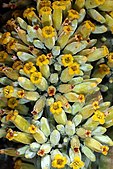| Kalanchoe thyrsiflora | |
|---|---|
 | |
| Kalanchoe thyrsiflora | |
| Scientific classification | |
| Kingdom: | Plantae |
| Clade: | Tracheophytes |
| Clade: | Angiosperms |
| Clade: | Eudicots |
| Order: | Saxifragales |
| Family: | Crassulaceae |
| Genus: | Kalanchoe |
| Species: | K. thyrsiflora |
| Binomial name | |
| Kalanchoe thyrsiflora | |
| Synonyms [1] | |
| |
Kalanchoe thyrsiflora (also known as paddle plant, flapjacks, desert cabbage, white lady, geelplakkie, meelplakkie, or plakkie[ citation needed ]) is a species of flowering plant in the Stonecrop Family (Crassulaceae) and native to Botswana, Lesotho, South Africa and Eswatini. This plant is rare in cultivation, and those plants labelled as "Kalanchoe thyrsiflora" in horticulture are mostly another similar species, Kalanchoe luciae . [2] [3] It is one of the few succulents which flower and fruit once only (monocarpic). [4] A peculiarity of the species is that the round leaves are held in a vertical posture.




